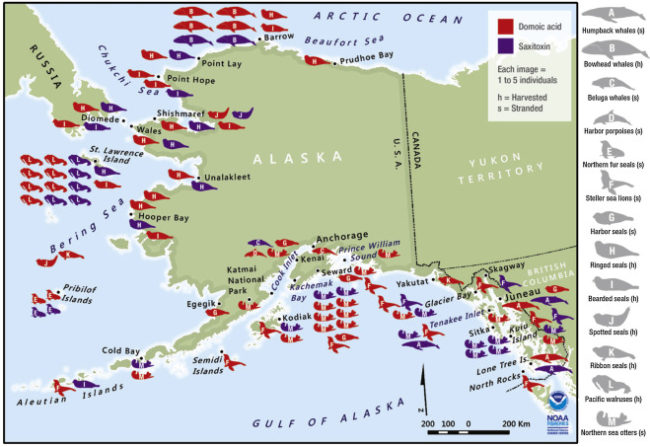
For the first time, scientists have documented the prevalence of two biotoxins in Alaska’s marine mammal population above the Arctic Circle.
That’s according to a new study out Thursday in the Journal Harmful Algae. But it’s not clear if algal toxins have always existed in the Arctic, because scientist never looked before now.
Scientists did not expect to find algal toxins in ocean water or marine mammals that range north of the Gulf of Alaska and the state’s Southeast region.
“This is really important, because these are animals that are integral to the culture and the community and food security here in Alaska,” said Frances Gulland, a commissioner with the federal Marine Mammal Commission. She co-authored the new study.
“There are detectable levels that have actually been measured of two different biotoxins: domoic acid and saxitoxin and both these toxins are produced by harmful algal blooms,” Gulland said.
The two are known to cause amnesic shellfish disorder and paralytic shellfish disorder in people.
“Now that we see that algae is there,” said Gay Sheffield, a biologist with the Alaska SeaGrant Marine Advisory Program and a study co-author.
“What would be the best coarse of action to make it comprehensive knowledge is to find out how our Russian neighbors have seen any of these unusual algaes or if they have any unusual concerns and more importantly is there traditional knowledge on shellfish poisoning or algal blooms or is there strange behavioral events with marine mammals,” she said.
After algae dies in the ocean, what’s left gets consumed – or filtered – by shellfish like clams and mussels, staple foods for many marine mammals. So, if there are algal toxins present they could end up in the gut contents of an unsuspecting Pacific Walrus, for example. Sheffield said of the 13 marine mammal species sampled over the course of nearly a decade, walrus had the highest levels of algal toxins.
“Because its such an important subsistence food item for the Bering Strait, there’s of course interest both from an animal health perspective, but a public health, human health, food security as well, but right now, there’s no problem,” said Sheffield.
According to the study, levels of algal toxins measured do not exceed regulatory limits for seafood safety in Alaska, or at the federal level. It’s also not clear if the toxins have always been present in the Far North, because scientists never tested for them before now.
Frances Gulland added that the study is not only limited in size, but the data itself can’t provide information about the magnitude of exposure, because toxins like domoic acid are cleared from an animals bloodstream and the gastrointestinal system so quickly.
“If the animal ate some food 10 minutes ago that was full of domoic acid, it would have a high level, but if its 12 hours since the animal ate, the levels will be lower,” she said.
“If it’s two days since the animal ate, the levels will be really low,” said Gulland. “So, really the data are limited because they’re only telling you what’s in that snapshot in time.”
Research does indicate an increase in the occurrence of algal blooms in the Arctic. Gulland believes that’s due to warming ocean temperatures and changes in sea ice.
“They’re plants, they grow, they are temperature dependent,” she said, “so clearly, with warmer waters, they’re going to replicate quicker, so its sensible to assume that temperature is important, but there also changes in micro-nutrients – things like iron and different components of water – that will affect how they bloom as well.”
Funding for study sampling came from the U.S. Fish and Wildlife Service, the National Marine Fisheries Service and the Alaska Department of Fish and Game. Additional money came from the National Institute of Health and the National Science Foundation.
